Financial Management Assignment: APC308 Valuation and Investment
VerifiedAdded on 2023/01/10
|14
|3293
|31
Homework Assignment
AI Summary
This assignment solution addresses key concepts in financial management, including valuation techniques and investment appraisal methods. The first section provides a detailed analysis of the Price Earning (P/E) ratio, Dividend Valuation Method, and Discounted Cash Flow (DCF) method, explaining their formulas, applications, and interpretations. It includes calculations for P/E ratio, return on equity, and the application of the dividend valuation method to determine share prices, alongside a WACC calculation. The second part of the solution discusses the limitations and problems associated with each valuation technique, such as the reliance on accounting standards in the P/E ratio, the inability of the dividend valuation method to value non-dividend-paying companies, and the uncertainties in forecasting cash flows in the DCF model. The assignment concludes with an examination of investment appraisal techniques like payback period, accounting rate of return, net present value (NPV), and internal rate of return (IRR) with associated calculations and interpretations, providing a comprehensive overview of financial analysis and decision-making.
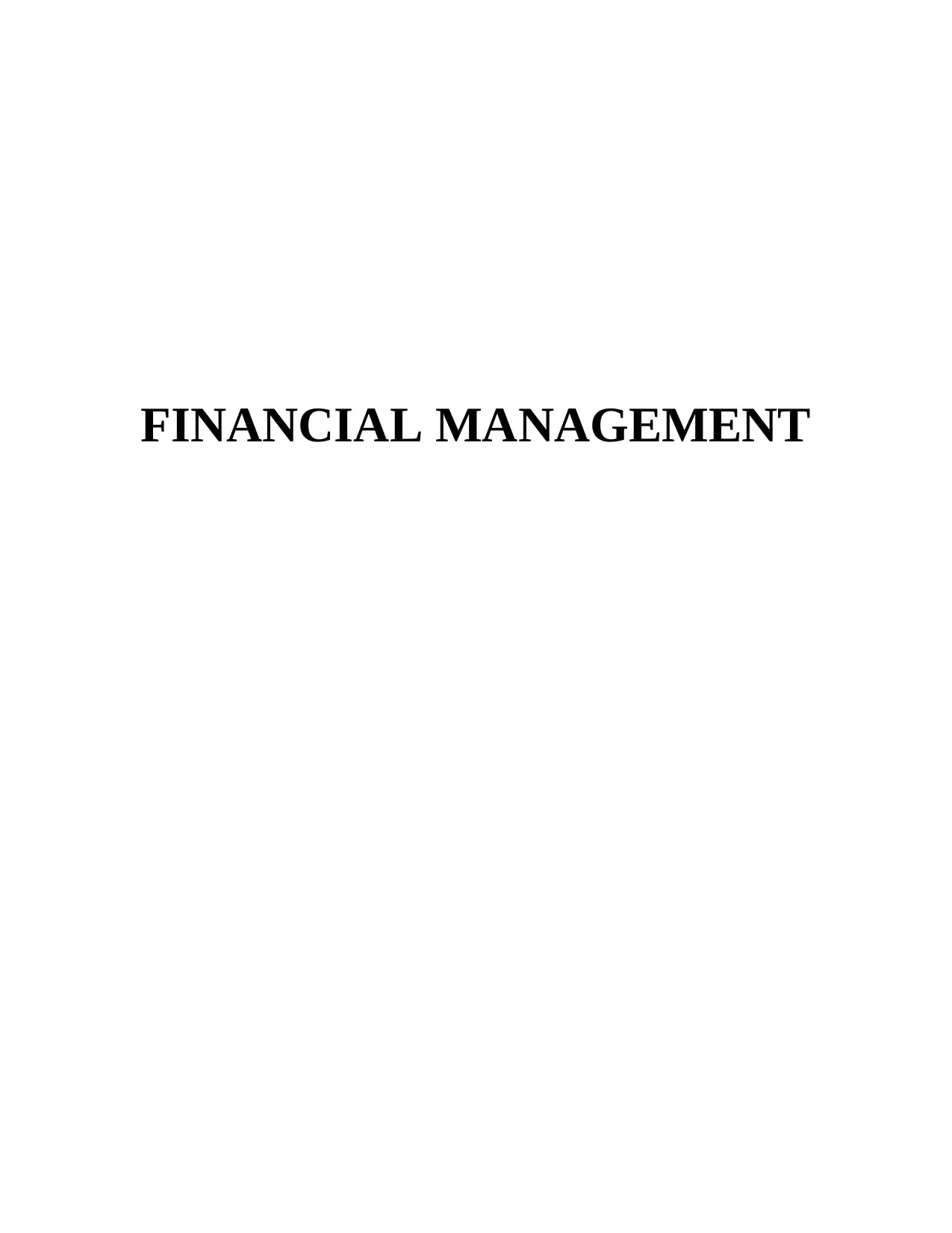
FINANCIAL MANAGEMENT
Paraphrase This Document
Need a fresh take? Get an instant paraphrase of this document with our AI Paraphraser
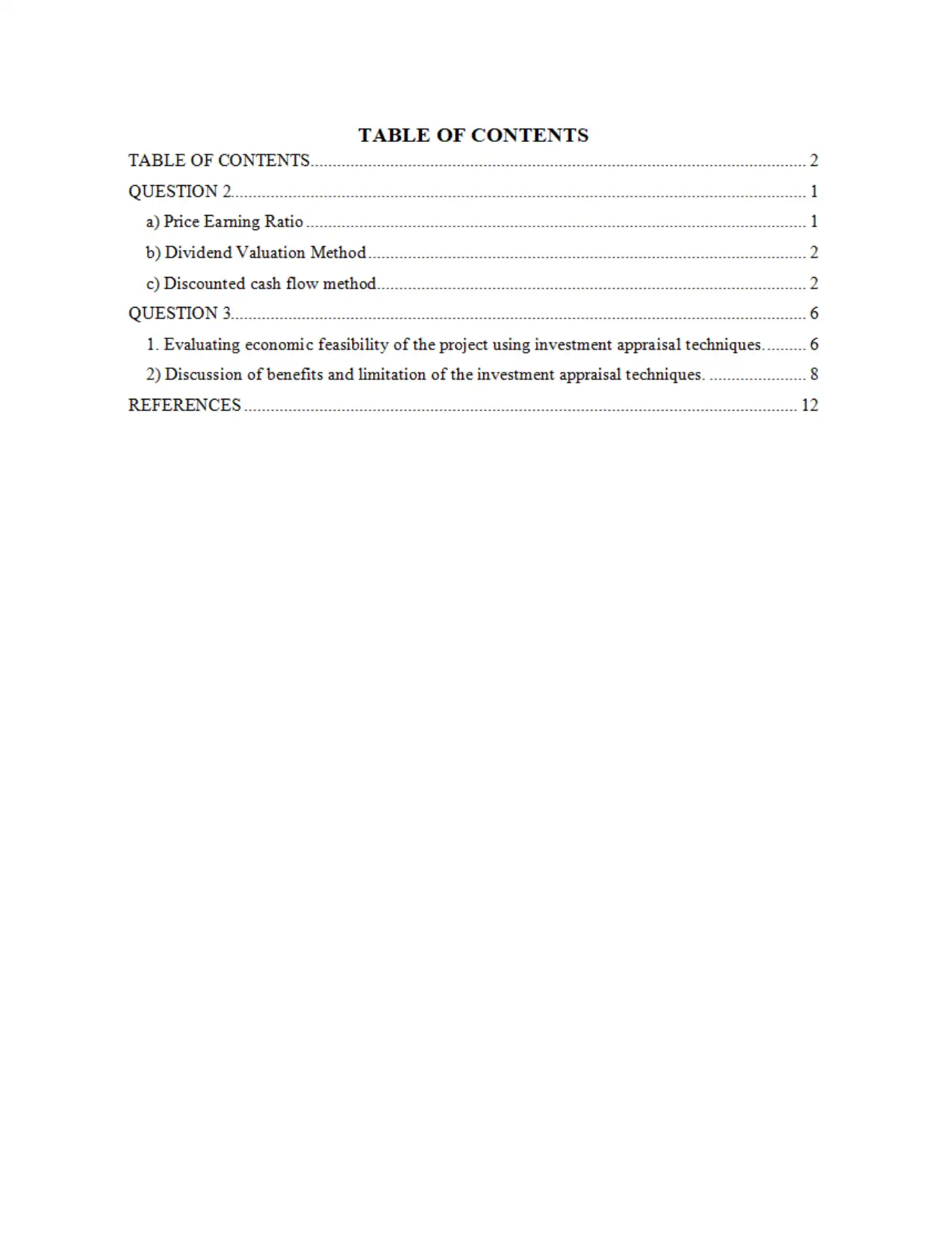
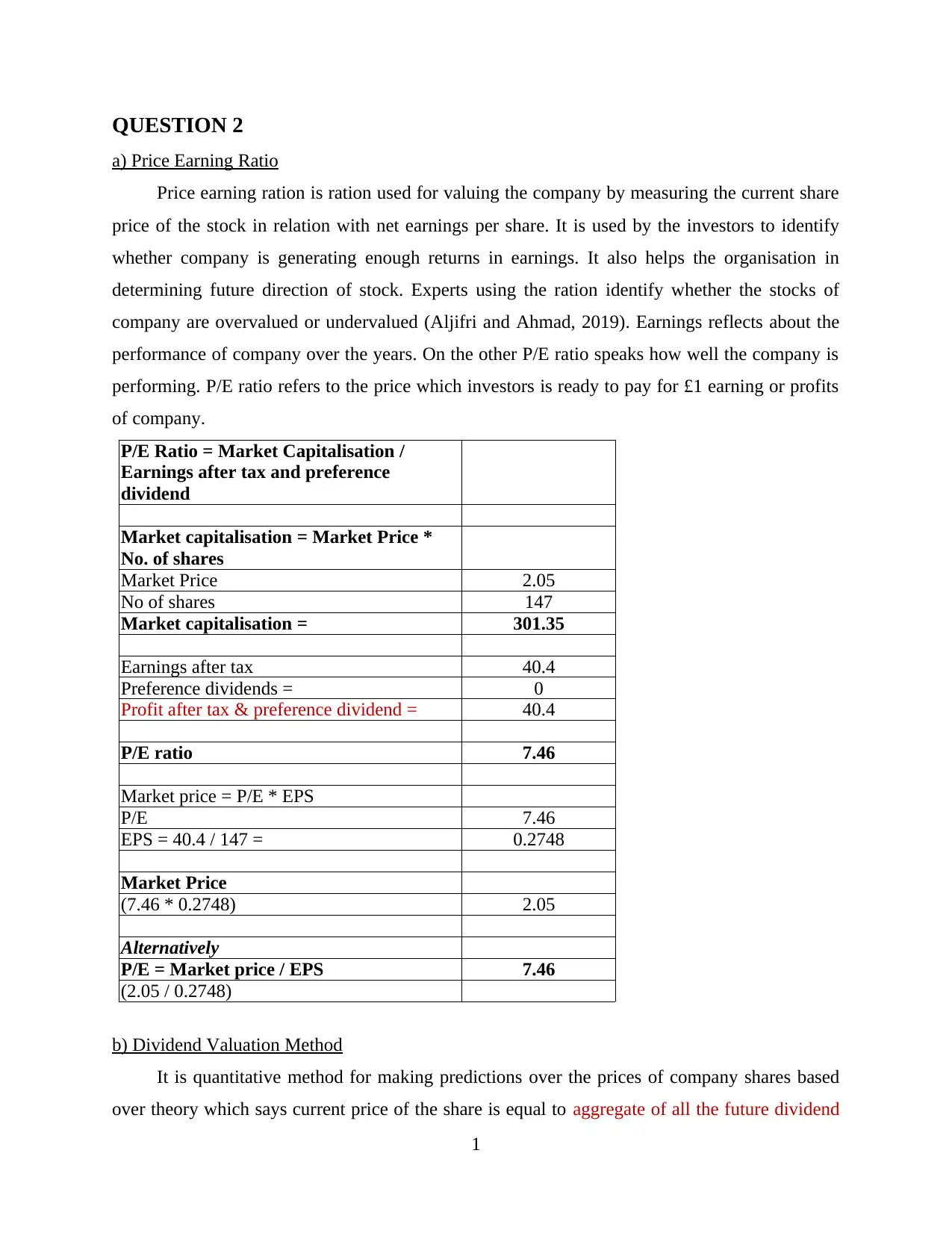
QUESTION 2
a) Price Earning Ratio
Price earning ration is ration used for valuing the company by measuring the current share
price of the stock in relation with net earnings per share. It is used by the investors to identify
whether company is generating enough returns in earnings. It also helps the organisation in
determining future direction of stock. Experts using the ration identify whether the stocks of
company are overvalued or undervalued (Aljifri and Ahmad, 2019). Earnings reflects about the
performance of company over the years. On the other P/E ratio speaks how well the company is
performing. P/E ratio refers to the price which investors is ready to pay for £1 earning or profits
of company.
P/E Ratio = Market Capitalisation /
Earnings after tax and preference
dividend
Market capitalisation = Market Price *
No. of shares
Market Price 2.05
No of shares 147
Market capitalisation = 301.35
Earnings after tax 40.4
Preference dividends = 0
Profit after tax & preference dividend = 40.4
P/E ratio 7.46
Market price = P/E * EPS
P/E 7.46
EPS = 40.4 / 147 = 0.2748
Market Price
(7.46 * 0.2748) 2.05
Alternatively
P/E = Market price / EPS 7.46
(2.05 / 0.2748)
b) Dividend Valuation Method
It is quantitative method for making predictions over the prices of company shares based
over theory which says current price of the share is equal to aggregate of all the future dividend
1
a) Price Earning Ratio
Price earning ration is ration used for valuing the company by measuring the current share
price of the stock in relation with net earnings per share. It is used by the investors to identify
whether company is generating enough returns in earnings. It also helps the organisation in
determining future direction of stock. Experts using the ration identify whether the stocks of
company are overvalued or undervalued (Aljifri and Ahmad, 2019). Earnings reflects about the
performance of company over the years. On the other P/E ratio speaks how well the company is
performing. P/E ratio refers to the price which investors is ready to pay for £1 earning or profits
of company.
P/E Ratio = Market Capitalisation /
Earnings after tax and preference
dividend
Market capitalisation = Market Price *
No. of shares
Market Price 2.05
No of shares 147
Market capitalisation = 301.35
Earnings after tax 40.4
Preference dividends = 0
Profit after tax & preference dividend = 40.4
P/E ratio 7.46
Market price = P/E * EPS
P/E 7.46
EPS = 40.4 / 147 = 0.2748
Market Price
(7.46 * 0.2748) 2.05
Alternatively
P/E = Market price / EPS 7.46
(2.05 / 0.2748)
b) Dividend Valuation Method
It is quantitative method for making predictions over the prices of company shares based
over theory which says current price of the share is equal to aggregate of all the future dividend
1
⊘ This is a preview!⊘
Do you want full access?
Subscribe today to unlock all pages.

Trusted by 1+ million students worldwide
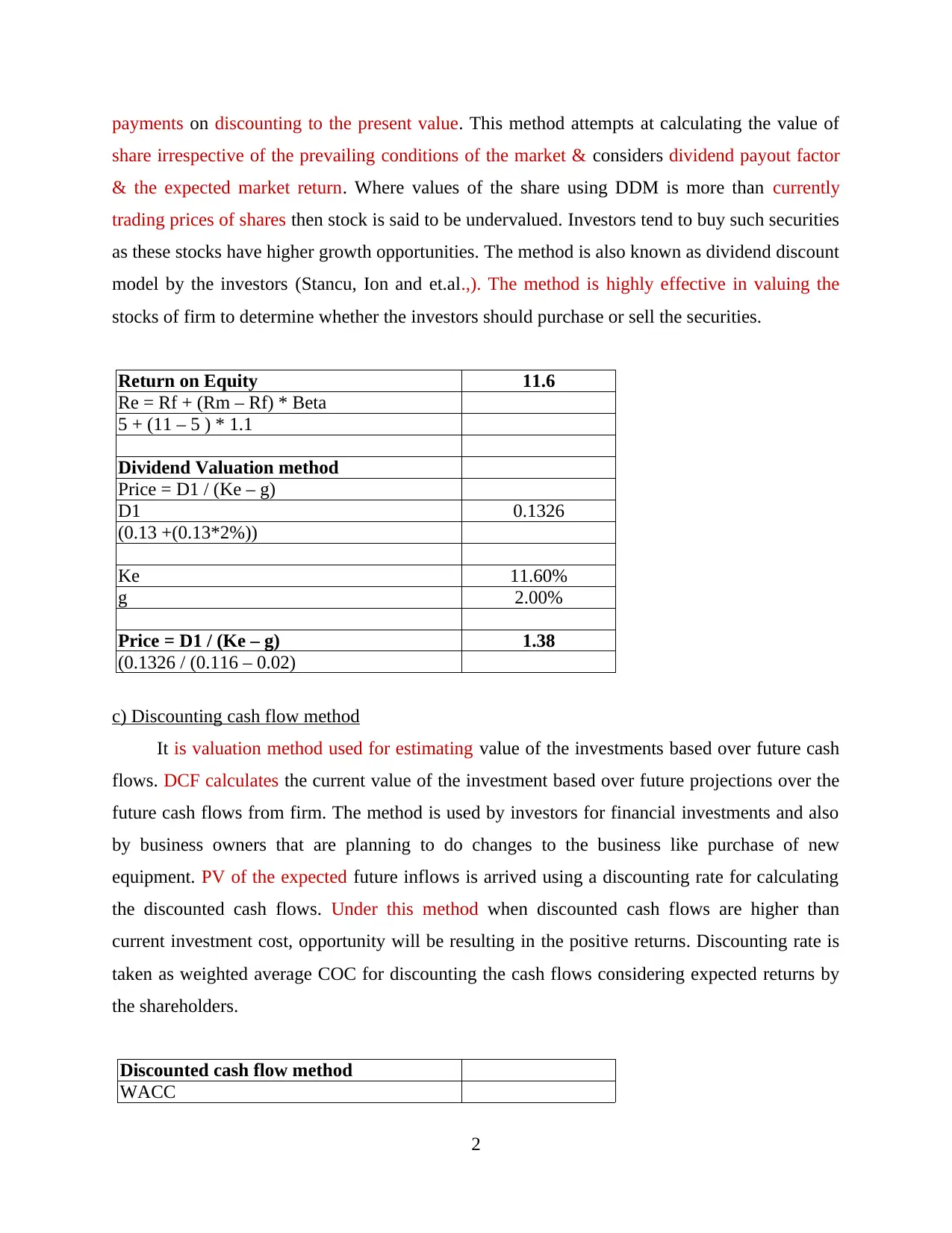
payments on discounting to the present value. This method attempts at calculating the value of
share irrespective of the prevailing conditions of the market & considers dividend payout factor
& the expected market return. Where values of the share using DDM is more than currently
trading prices of shares then stock is said to be undervalued. Investors tend to buy such securities
as these stocks have higher growth opportunities. The method is also known as dividend discount
model by the investors (Stancu, Ion and et.al.,). The method is highly effective in valuing the
stocks of firm to determine whether the investors should purchase or sell the securities.
Return on Equity 11.6
Re = Rf + (Rm – Rf) * Beta
5 + (11 – 5 ) * 1.1
Dividend Valuation method
Price = D1 / (Ke – g)
D1 0.1326
(0.13 +(0.13*2%))
Ke 11.60%
g 2.00%
Price = D1 / (Ke – g) 1.38
(0.1326 / (0.116 – 0.02)
c) Discounting cash flow method
It is valuation method used for estimating value of the investments based over future cash
flows. DCF calculates the current value of the investment based over future projections over the
future cash flows from firm. The method is used by investors for financial investments and also
by business owners that are planning to do changes to the business like purchase of new
equipment. PV of the expected future inflows is arrived using a discounting rate for calculating
the discounted cash flows. Under this method when discounted cash flows are higher than
current investment cost, opportunity will be resulting in the positive returns. Discounting rate is
taken as weighted average COC for discounting the cash flows considering expected returns by
the shareholders.
Discounted cash flow method
WACC
2
share irrespective of the prevailing conditions of the market & considers dividend payout factor
& the expected market return. Where values of the share using DDM is more than currently
trading prices of shares then stock is said to be undervalued. Investors tend to buy such securities
as these stocks have higher growth opportunities. The method is also known as dividend discount
model by the investors (Stancu, Ion and et.al.,). The method is highly effective in valuing the
stocks of firm to determine whether the investors should purchase or sell the securities.
Return on Equity 11.6
Re = Rf + (Rm – Rf) * Beta
5 + (11 – 5 ) * 1.1
Dividend Valuation method
Price = D1 / (Ke – g)
D1 0.1326
(0.13 +(0.13*2%))
Ke 11.60%
g 2.00%
Price = D1 / (Ke – g) 1.38
(0.1326 / (0.116 – 0.02)
c) Discounting cash flow method
It is valuation method used for estimating value of the investments based over future cash
flows. DCF calculates the current value of the investment based over future projections over the
future cash flows from firm. The method is used by investors for financial investments and also
by business owners that are planning to do changes to the business like purchase of new
equipment. PV of the expected future inflows is arrived using a discounting rate for calculating
the discounted cash flows. Under this method when discounted cash flows are higher than
current investment cost, opportunity will be resulting in the positive returns. Discounting rate is
taken as weighted average COC for discounting the cash flows considering expected returns by
the shareholders.
Discounted cash flow method
WACC
2
Paraphrase This Document
Need a fresh take? Get an instant paraphrase of this document with our AI Paraphraser
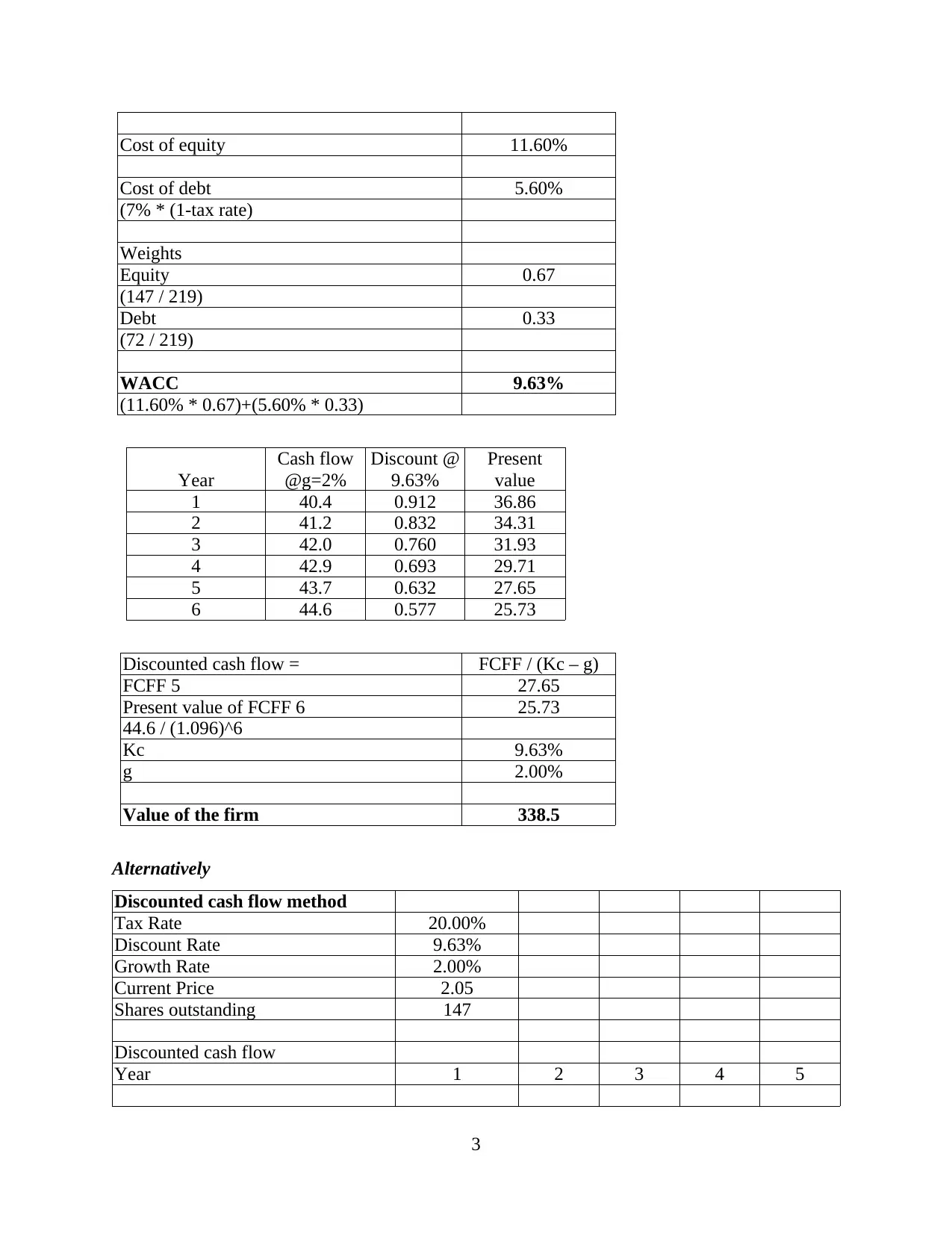
Cost of equity 11.60%
Cost of debt 5.60%
(7% * (1-tax rate)
Weights
Equity 0.67
(147 / 219)
Debt 0.33
(72 / 219)
WACC 9.63%
(11.60% * 0.67)+(5.60% * 0.33)
Year
Cash flow
@g=2%
Discount @
9.63%
Present
value
1 40.4 0.912 36.86
2 41.2 0.832 34.31
3 42.0 0.760 31.93
4 42.9 0.693 29.71
5 43.7 0.632 27.65
6 44.6 0.577 25.73
Discounted cash flow = FCFF / (Kc – g)
FCFF 5 27.65
Present value of FCFF 6 25.73
44.6 / (1.096)^6
Kc 9.63%
g 2.00%
Value of the firm 338.5
Alternatively
Discounted cash flow method
Tax Rate 20.00%
Discount Rate 9.63%
Growth Rate 2.00%
Current Price 2.05
Shares outstanding 147
Discounted cash flow
Year 1 2 3 4 5
3
Cost of debt 5.60%
(7% * (1-tax rate)
Weights
Equity 0.67
(147 / 219)
Debt 0.33
(72 / 219)
WACC 9.63%
(11.60% * 0.67)+(5.60% * 0.33)
Year
Cash flow
@g=2%
Discount @
9.63%
Present
value
1 40.4 0.912 36.86
2 41.2 0.832 34.31
3 42.0 0.760 31.93
4 42.9 0.693 29.71
5 43.7 0.632 27.65
6 44.6 0.577 25.73
Discounted cash flow = FCFF / (Kc – g)
FCFF 5 27.65
Present value of FCFF 6 25.73
44.6 / (1.096)^6
Kc 9.63%
g 2.00%
Value of the firm 338.5
Alternatively
Discounted cash flow method
Tax Rate 20.00%
Discount Rate 9.63%
Growth Rate 2.00%
Current Price 2.05
Shares outstanding 147
Discounted cash flow
Year 1 2 3 4 5
3
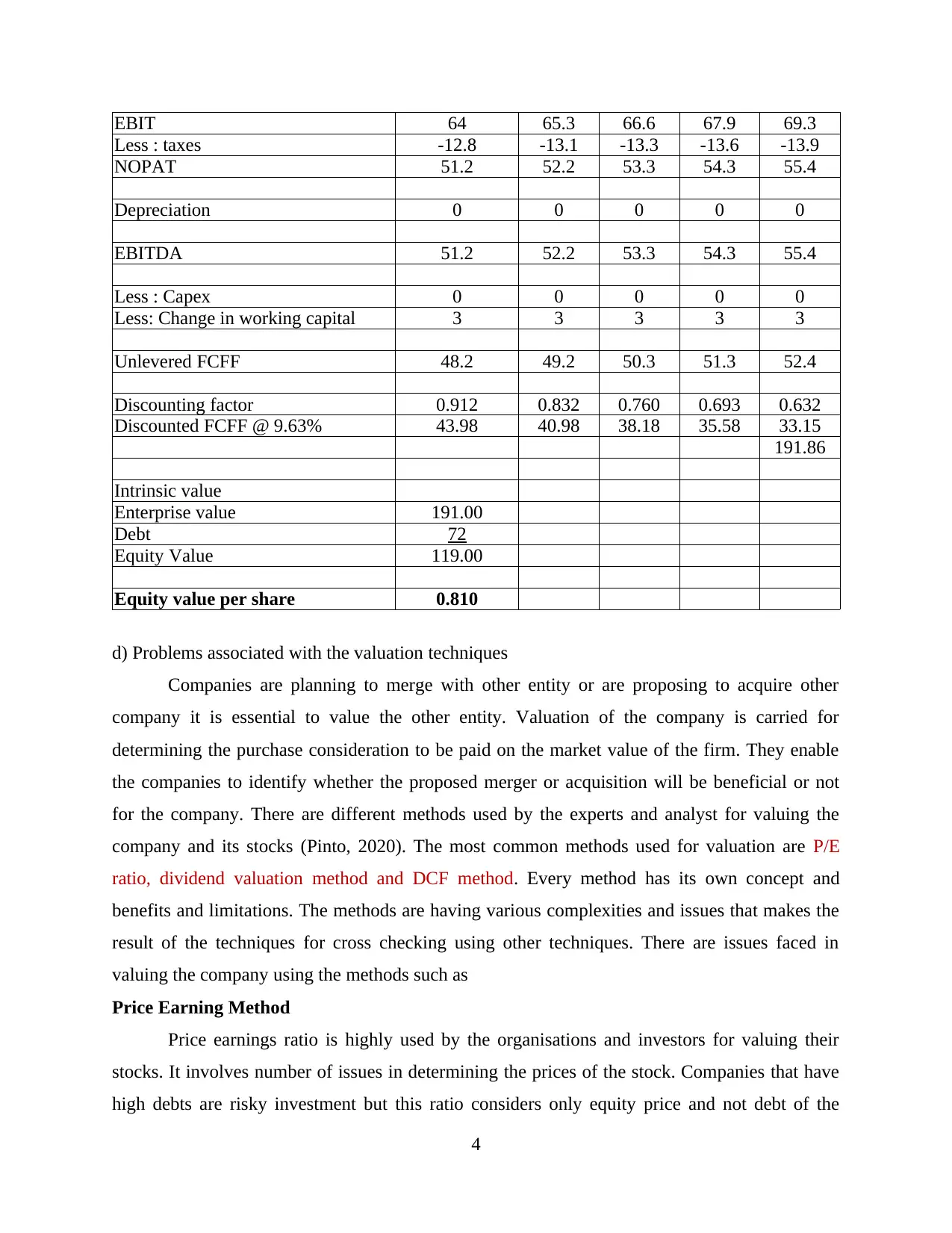
EBIT 64 65.3 66.6 67.9 69.3
Less : taxes -12.8 -13.1 -13.3 -13.6 -13.9
NOPAT 51.2 52.2 53.3 54.3 55.4
Depreciation 0 0 0 0 0
EBITDA 51.2 52.2 53.3 54.3 55.4
Less : Capex 0 0 0 0 0
Less: Change in working capital 3 3 3 3 3
Unlevered FCFF 48.2 49.2 50.3 51.3 52.4
Discounting factor 0.912 0.832 0.760 0.693 0.632
Discounted FCFF @ 9.63% 43.98 40.98 38.18 35.58 33.15
191.86
Intrinsic value
Enterprise value 191.00
Debt 72
Equity Value 119.00
Equity value per share 0.810
d) Problems associated with the valuation techniques
Companies are planning to merge with other entity or are proposing to acquire other
company it is essential to value the other entity. Valuation of the company is carried for
determining the purchase consideration to be paid on the market value of the firm. They enable
the companies to identify whether the proposed merger or acquisition will be beneficial or not
for the company. There are different methods used by the experts and analyst for valuing the
company and its stocks (Pinto, 2020). The most common methods used for valuation are P/E
ratio, dividend valuation method and DCF method. Every method has its own concept and
benefits and limitations. The methods are having various complexities and issues that makes the
result of the techniques for cross checking using other techniques. There are issues faced in
valuing the company using the methods such as
Price Earning Method
Price earnings ratio is highly used by the organisations and investors for valuing their
stocks. It involves number of issues in determining the prices of the stock. Companies that have
high debts are risky investment but this ratio considers only equity price and not debt of the
4
Less : taxes -12.8 -13.1 -13.3 -13.6 -13.9
NOPAT 51.2 52.2 53.3 54.3 55.4
Depreciation 0 0 0 0 0
EBITDA 51.2 52.2 53.3 54.3 55.4
Less : Capex 0 0 0 0 0
Less: Change in working capital 3 3 3 3 3
Unlevered FCFF 48.2 49.2 50.3 51.3 52.4
Discounting factor 0.912 0.832 0.760 0.693 0.632
Discounted FCFF @ 9.63% 43.98 40.98 38.18 35.58 33.15
191.86
Intrinsic value
Enterprise value 191.00
Debt 72
Equity Value 119.00
Equity value per share 0.810
d) Problems associated with the valuation techniques
Companies are planning to merge with other entity or are proposing to acquire other
company it is essential to value the other entity. Valuation of the company is carried for
determining the purchase consideration to be paid on the market value of the firm. They enable
the companies to identify whether the proposed merger or acquisition will be beneficial or not
for the company. There are different methods used by the experts and analyst for valuing the
company and its stocks (Pinto, 2020). The most common methods used for valuation are P/E
ratio, dividend valuation method and DCF method. Every method has its own concept and
benefits and limitations. The methods are having various complexities and issues that makes the
result of the techniques for cross checking using other techniques. There are issues faced in
valuing the company using the methods such as
Price Earning Method
Price earnings ratio is highly used by the organisations and investors for valuing their
stocks. It involves number of issues in determining the prices of the stock. Companies that have
high debts are risky investment but this ratio considers only equity price and not debt of the
4
⊘ This is a preview!⊘
Do you want full access?
Subscribe today to unlock all pages.

Trusted by 1+ million students worldwide
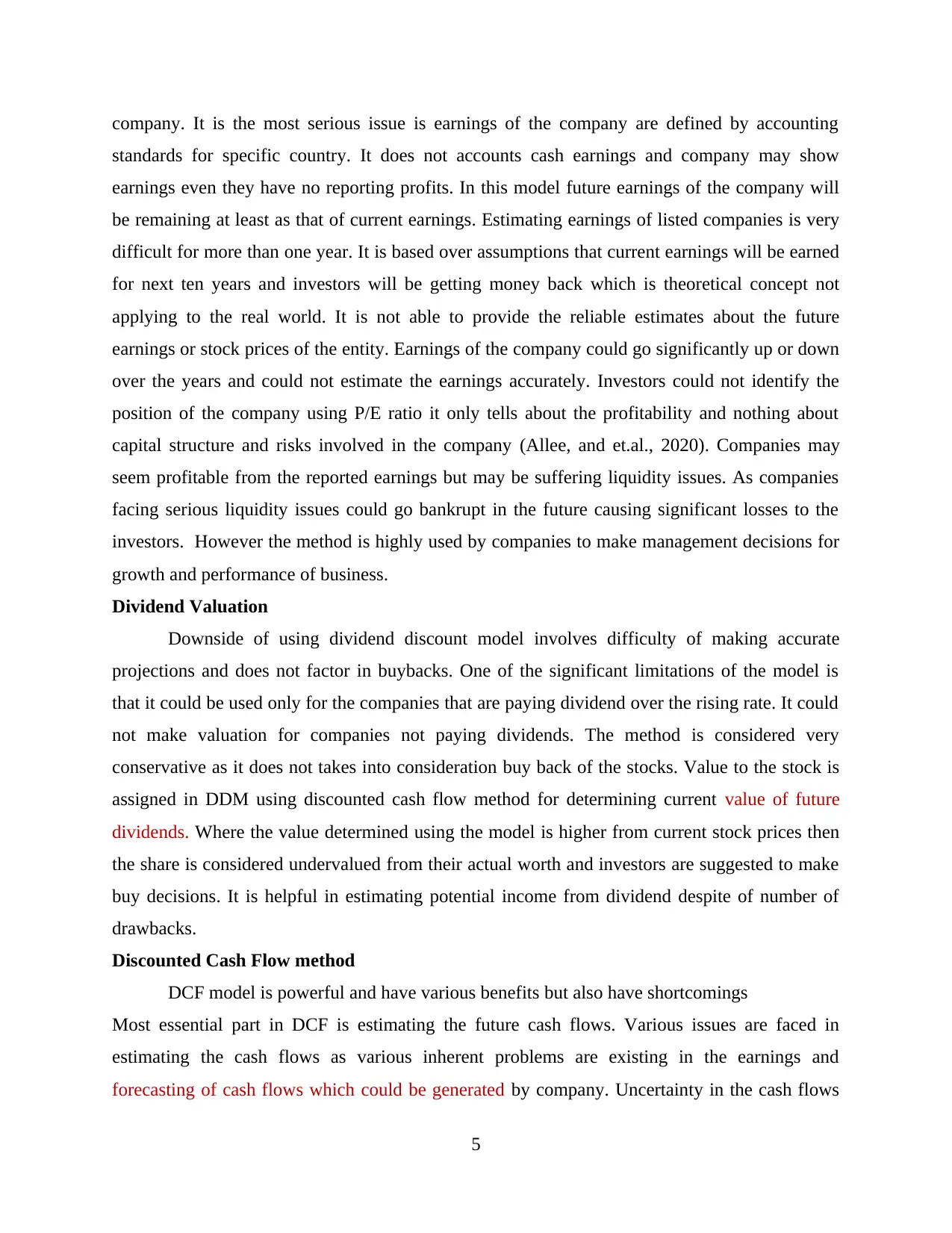
company. It is the most serious issue is earnings of the company are defined by accounting
standards for specific country. It does not accounts cash earnings and company may show
earnings even they have no reporting profits. In this model future earnings of the company will
be remaining at least as that of current earnings. Estimating earnings of listed companies is very
difficult for more than one year. It is based over assumptions that current earnings will be earned
for next ten years and investors will be getting money back which is theoretical concept not
applying to the real world. It is not able to provide the reliable estimates about the future
earnings or stock prices of the entity. Earnings of the company could go significantly up or down
over the years and could not estimate the earnings accurately. Investors could not identify the
position of the company using P/E ratio it only tells about the profitability and nothing about
capital structure and risks involved in the company (Allee, and et.al., 2020). Companies may
seem profitable from the reported earnings but may be suffering liquidity issues. As companies
facing serious liquidity issues could go bankrupt in the future causing significant losses to the
investors. However the method is highly used by companies to make management decisions for
growth and performance of business.
Dividend Valuation
Downside of using dividend discount model involves difficulty of making accurate
projections and does not factor in buybacks. One of the significant limitations of the model is
that it could be used only for the companies that are paying dividend over the rising rate. It could
not make valuation for companies not paying dividends. The method is considered very
conservative as it does not takes into consideration buy back of the stocks. Value to the stock is
assigned in DDM using discounted cash flow method for determining current value of future
dividends. Where the value determined using the model is higher from current stock prices then
the share is considered undervalued from their actual worth and investors are suggested to make
buy decisions. It is helpful in estimating potential income from dividend despite of number of
drawbacks.
Discounted Cash Flow method
DCF model is powerful and have various benefits but also have shortcomings
Most essential part in DCF is estimating the future cash flows. Various issues are faced in
estimating the cash flows as various inherent problems are existing in the earnings and
forecasting of cash flows which could be generated by company. Uncertainty in the cash flows
5
standards for specific country. It does not accounts cash earnings and company may show
earnings even they have no reporting profits. In this model future earnings of the company will
be remaining at least as that of current earnings. Estimating earnings of listed companies is very
difficult for more than one year. It is based over assumptions that current earnings will be earned
for next ten years and investors will be getting money back which is theoretical concept not
applying to the real world. It is not able to provide the reliable estimates about the future
earnings or stock prices of the entity. Earnings of the company could go significantly up or down
over the years and could not estimate the earnings accurately. Investors could not identify the
position of the company using P/E ratio it only tells about the profitability and nothing about
capital structure and risks involved in the company (Allee, and et.al., 2020). Companies may
seem profitable from the reported earnings but may be suffering liquidity issues. As companies
facing serious liquidity issues could go bankrupt in the future causing significant losses to the
investors. However the method is highly used by companies to make management decisions for
growth and performance of business.
Dividend Valuation
Downside of using dividend discount model involves difficulty of making accurate
projections and does not factor in buybacks. One of the significant limitations of the model is
that it could be used only for the companies that are paying dividend over the rising rate. It could
not make valuation for companies not paying dividends. The method is considered very
conservative as it does not takes into consideration buy back of the stocks. Value to the stock is
assigned in DDM using discounted cash flow method for determining current value of future
dividends. Where the value determined using the model is higher from current stock prices then
the share is considered undervalued from their actual worth and investors are suggested to make
buy decisions. It is helpful in estimating potential income from dividend despite of number of
drawbacks.
Discounted Cash Flow method
DCF model is powerful and have various benefits but also have shortcomings
Most essential part in DCF is estimating the future cash flows. Various issues are faced in
estimating the cash flows as various inherent problems are existing in the earnings and
forecasting of cash flows which could be generated by company. Uncertainty in the cash flows
5
Paraphrase This Document
Need a fresh take? Get an instant paraphrase of this document with our AI Paraphraser
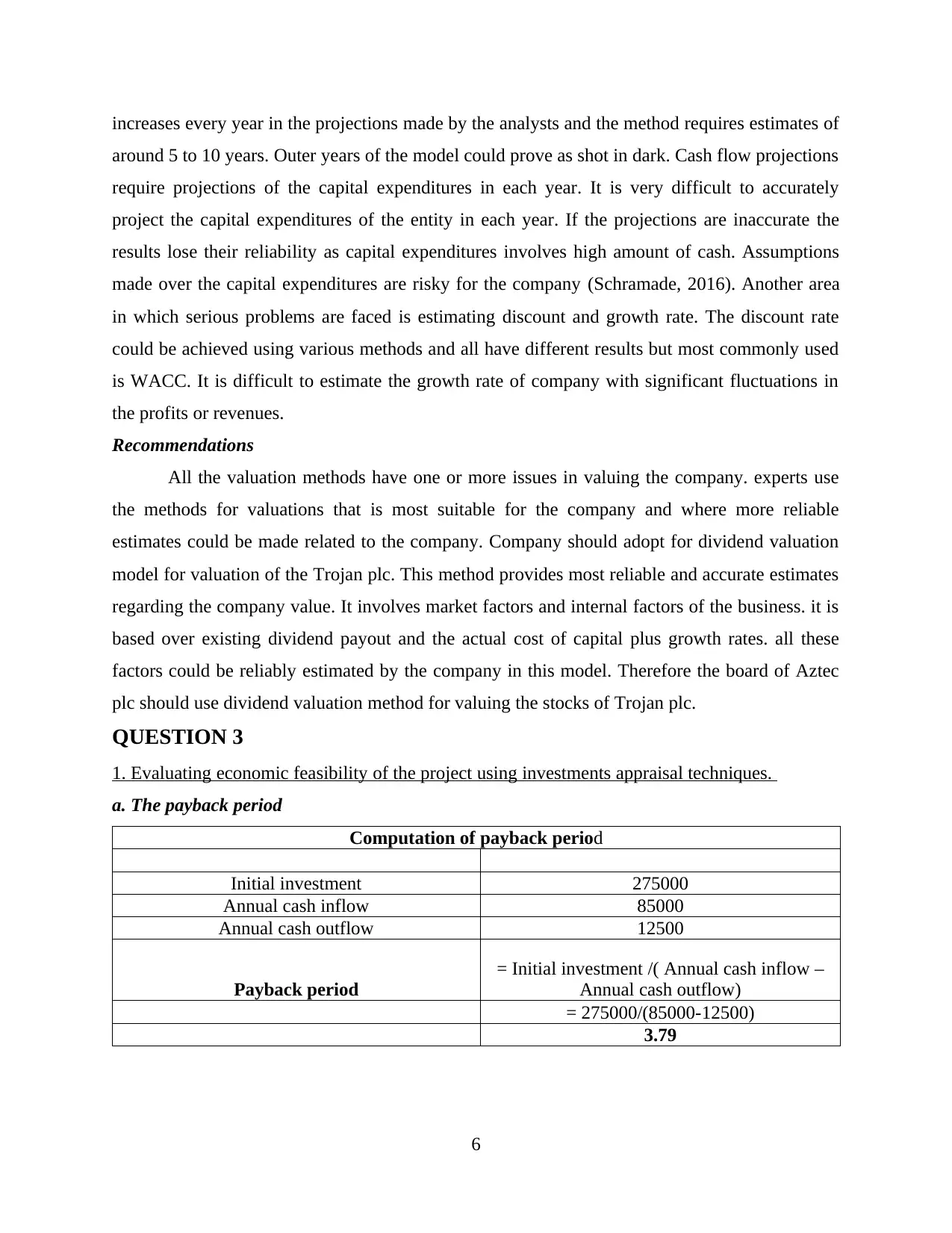
increases every year in the projections made by the analysts and the method requires estimates of
around 5 to 10 years. Outer years of the model could prove as shot in dark. Cash flow projections
require projections of the capital expenditures in each year. It is very difficult to accurately
project the capital expenditures of the entity in each year. If the projections are inaccurate the
results lose their reliability as capital expenditures involves high amount of cash. Assumptions
made over the capital expenditures are risky for the company (Schramade, 2016). Another area
in which serious problems are faced is estimating discount and growth rate. The discount rate
could be achieved using various methods and all have different results but most commonly used
is WACC. It is difficult to estimate the growth rate of company with significant fluctuations in
the profits or revenues.
Recommendations
All the valuation methods have one or more issues in valuing the company. experts use
the methods for valuations that is most suitable for the company and where more reliable
estimates could be made related to the company. Company should adopt for dividend valuation
model for valuation of the Trojan plc. This method provides most reliable and accurate estimates
regarding the company value. It involves market factors and internal factors of the business. it is
based over existing dividend payout and the actual cost of capital plus growth rates. all these
factors could be reliably estimated by the company in this model. Therefore the board of Aztec
plc should use dividend valuation method for valuing the stocks of Trojan plc.
QUESTION 3
1. Evaluating economic feasibility of the project using investments appraisal techniques.
a. The payback period
Computation of payback period
Initial investment 275000
Annual cash inflow 85000
Annual cash outflow 12500
Payback period
= Initial investment /( Annual cash inflow –
Annual cash outflow)
= 275000/(85000-12500)
3.79
6
around 5 to 10 years. Outer years of the model could prove as shot in dark. Cash flow projections
require projections of the capital expenditures in each year. It is very difficult to accurately
project the capital expenditures of the entity in each year. If the projections are inaccurate the
results lose their reliability as capital expenditures involves high amount of cash. Assumptions
made over the capital expenditures are risky for the company (Schramade, 2016). Another area
in which serious problems are faced is estimating discount and growth rate. The discount rate
could be achieved using various methods and all have different results but most commonly used
is WACC. It is difficult to estimate the growth rate of company with significant fluctuations in
the profits or revenues.
Recommendations
All the valuation methods have one or more issues in valuing the company. experts use
the methods for valuations that is most suitable for the company and where more reliable
estimates could be made related to the company. Company should adopt for dividend valuation
model for valuation of the Trojan plc. This method provides most reliable and accurate estimates
regarding the company value. It involves market factors and internal factors of the business. it is
based over existing dividend payout and the actual cost of capital plus growth rates. all these
factors could be reliably estimated by the company in this model. Therefore the board of Aztec
plc should use dividend valuation method for valuing the stocks of Trojan plc.
QUESTION 3
1. Evaluating economic feasibility of the project using investments appraisal techniques.
a. The payback period
Computation of payback period
Initial investment 275000
Annual cash inflow 85000
Annual cash outflow 12500
Payback period
= Initial investment /( Annual cash inflow –
Annual cash outflow)
= 275000/(85000-12500)
3.79
6
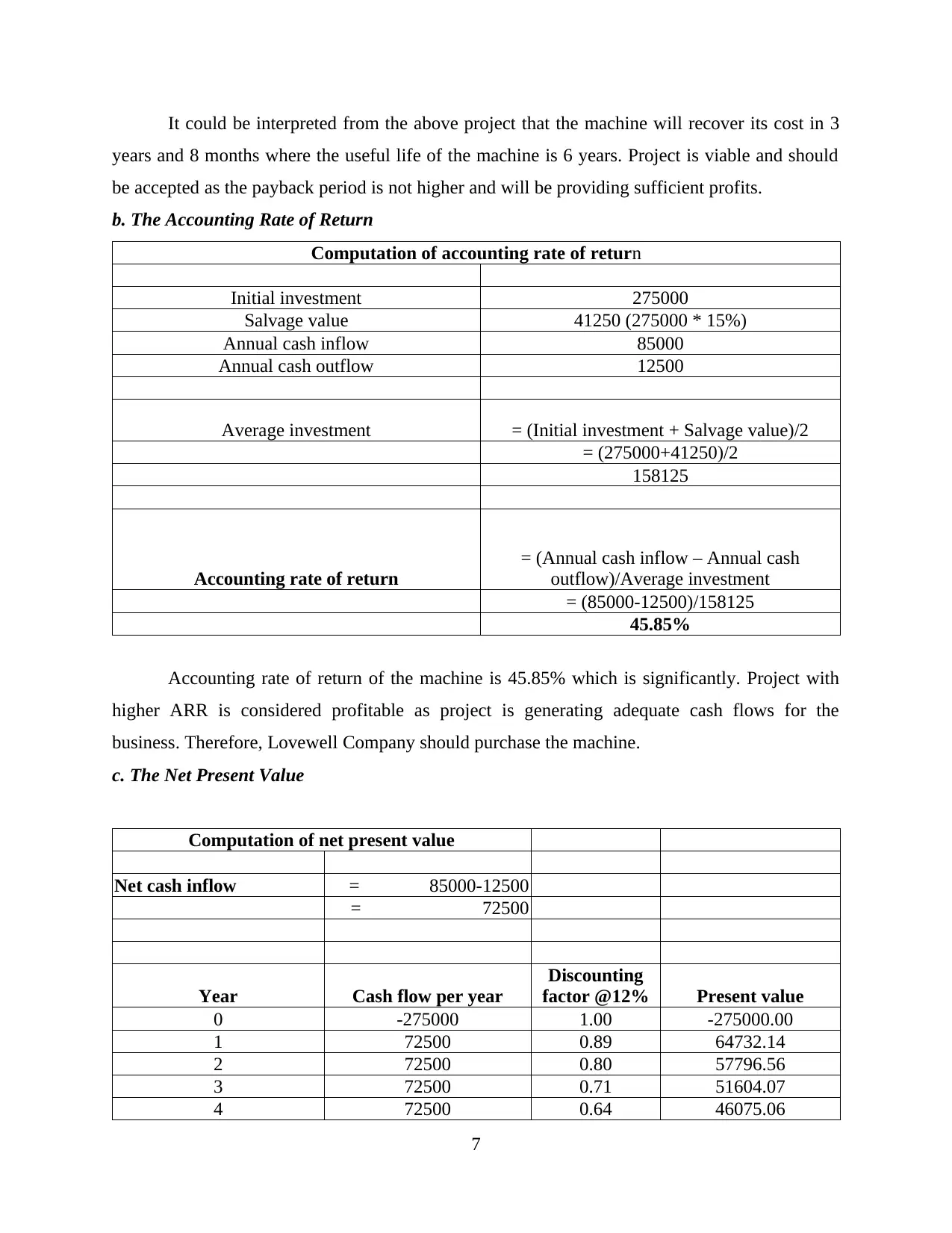
It could be interpreted from the above project that the machine will recover its cost in 3
years and 8 months where the useful life of the machine is 6 years. Project is viable and should
be accepted as the payback period is not higher and will be providing sufficient profits.
b. The Accounting Rate of Return
Computation of accounting rate of return
Initial investment 275000
Salvage value 41250 (275000 * 15%)
Annual cash inflow 85000
Annual cash outflow 12500
Average investment = (Initial investment + Salvage value)/2
= (275000+41250)/2
158125
Accounting rate of return
= (Annual cash inflow – Annual cash
outflow)/Average investment
= (85000-12500)/158125
45.85%
Accounting rate of return of the machine is 45.85% which is significantly. Project with
higher ARR is considered profitable as project is generating adequate cash flows for the
business. Therefore, Lovewell Company should purchase the machine.
c. The Net Present Value
Computation of net present value
Net cash inflow = 85000-12500
= 72500
Year Cash flow per year
Discounting
factor @12% Present value
0 -275000 1.00 -275000.00
1 72500 0.89 64732.14
2 72500 0.80 57796.56
3 72500 0.71 51604.07
4 72500 0.64 46075.06
7
years and 8 months where the useful life of the machine is 6 years. Project is viable and should
be accepted as the payback period is not higher and will be providing sufficient profits.
b. The Accounting Rate of Return
Computation of accounting rate of return
Initial investment 275000
Salvage value 41250 (275000 * 15%)
Annual cash inflow 85000
Annual cash outflow 12500
Average investment = (Initial investment + Salvage value)/2
= (275000+41250)/2
158125
Accounting rate of return
= (Annual cash inflow – Annual cash
outflow)/Average investment
= (85000-12500)/158125
45.85%
Accounting rate of return of the machine is 45.85% which is significantly. Project with
higher ARR is considered profitable as project is generating adequate cash flows for the
business. Therefore, Lovewell Company should purchase the machine.
c. The Net Present Value
Computation of net present value
Net cash inflow = 85000-12500
= 72500
Year Cash flow per year
Discounting
factor @12% Present value
0 -275000 1.00 -275000.00
1 72500 0.89 64732.14
2 72500 0.80 57796.56
3 72500 0.71 51604.07
4 72500 0.64 46075.06
7
⊘ This is a preview!⊘
Do you want full access?
Subscribe today to unlock all pages.

Trusted by 1+ million students worldwide
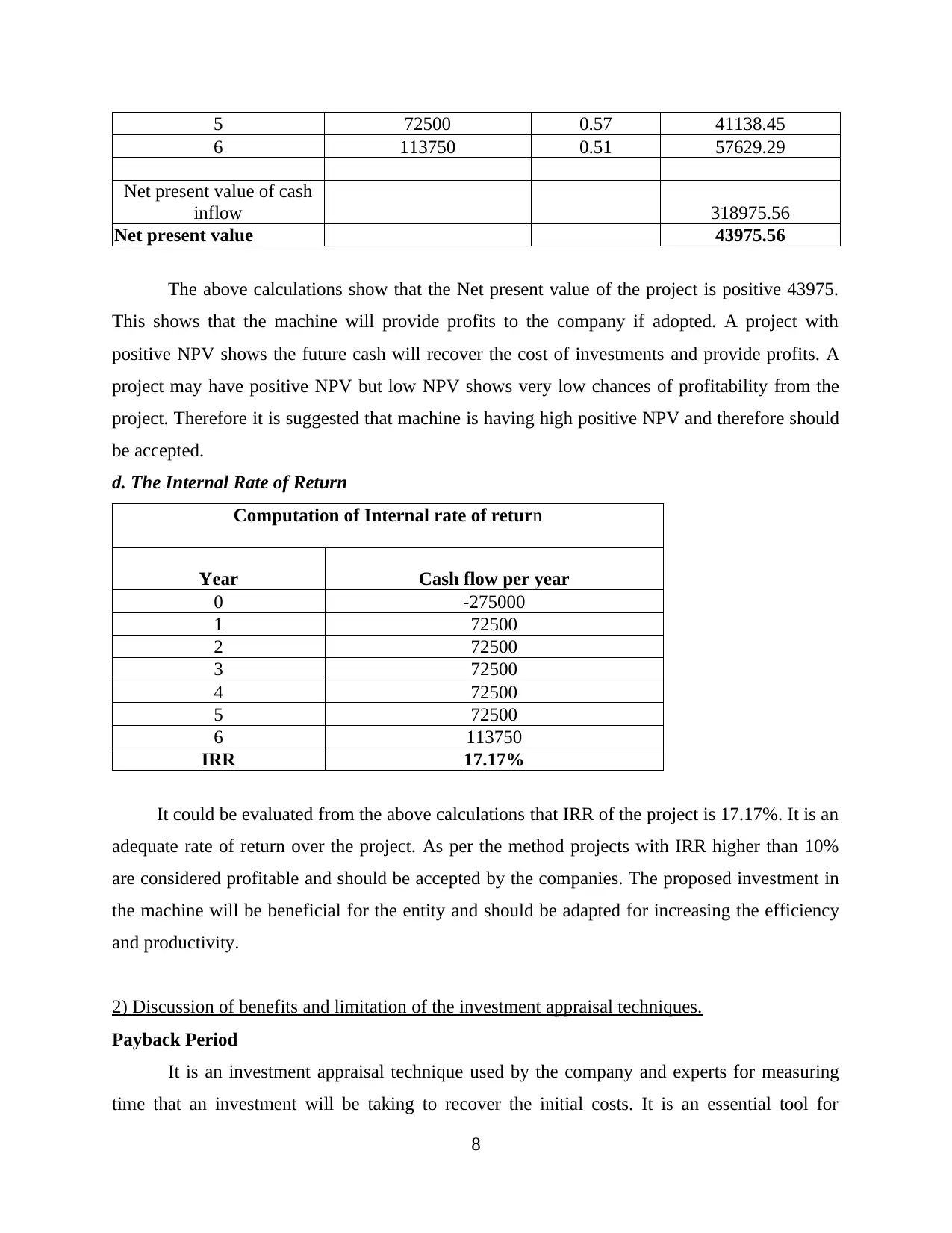
5 72500 0.57 41138.45
6 113750 0.51 57629.29
Net present value of cash
inflow 318975.56
Net present value 43975.56
The above calculations show that the Net present value of the project is positive 43975.
This shows that the machine will provide profits to the company if adopted. A project with
positive NPV shows the future cash will recover the cost of investments and provide profits. A
project may have positive NPV but low NPV shows very low chances of profitability from the
project. Therefore it is suggested that machine is having high positive NPV and therefore should
be accepted.
d. The Internal Rate of Return
Computation of Internal rate of return
Year Cash flow per year
0 -275000
1 72500
2 72500
3 72500
4 72500
5 72500
6 113750
IRR 17.17%
It could be evaluated from the above calculations that IRR of the project is 17.17%. It is an
adequate rate of return over the project. As per the method projects with IRR higher than 10%
are considered profitable and should be accepted by the companies. The proposed investment in
the machine will be beneficial for the entity and should be adapted for increasing the efficiency
and productivity.
2) Discussion of benefits and limitation of the investment appraisal techniques.
Payback Period
It is an investment appraisal technique used by the company and experts for measuring
time that an investment will be taking to recover the initial costs. It is an essential tool for
8
6 113750 0.51 57629.29
Net present value of cash
inflow 318975.56
Net present value 43975.56
The above calculations show that the Net present value of the project is positive 43975.
This shows that the machine will provide profits to the company if adopted. A project with
positive NPV shows the future cash will recover the cost of investments and provide profits. A
project may have positive NPV but low NPV shows very low chances of profitability from the
project. Therefore it is suggested that machine is having high positive NPV and therefore should
be accepted.
d. The Internal Rate of Return
Computation of Internal rate of return
Year Cash flow per year
0 -275000
1 72500
2 72500
3 72500
4 72500
5 72500
6 113750
IRR 17.17%
It could be evaluated from the above calculations that IRR of the project is 17.17%. It is an
adequate rate of return over the project. As per the method projects with IRR higher than 10%
are considered profitable and should be accepted by the companies. The proposed investment in
the machine will be beneficial for the entity and should be adapted for increasing the efficiency
and productivity.
2) Discussion of benefits and limitation of the investment appraisal techniques.
Payback Period
It is an investment appraisal technique used by the company and experts for measuring
time that an investment will be taking to recover the initial costs. It is an essential tool for
8
Paraphrase This Document
Need a fresh take? Get an instant paraphrase of this document with our AI Paraphraser
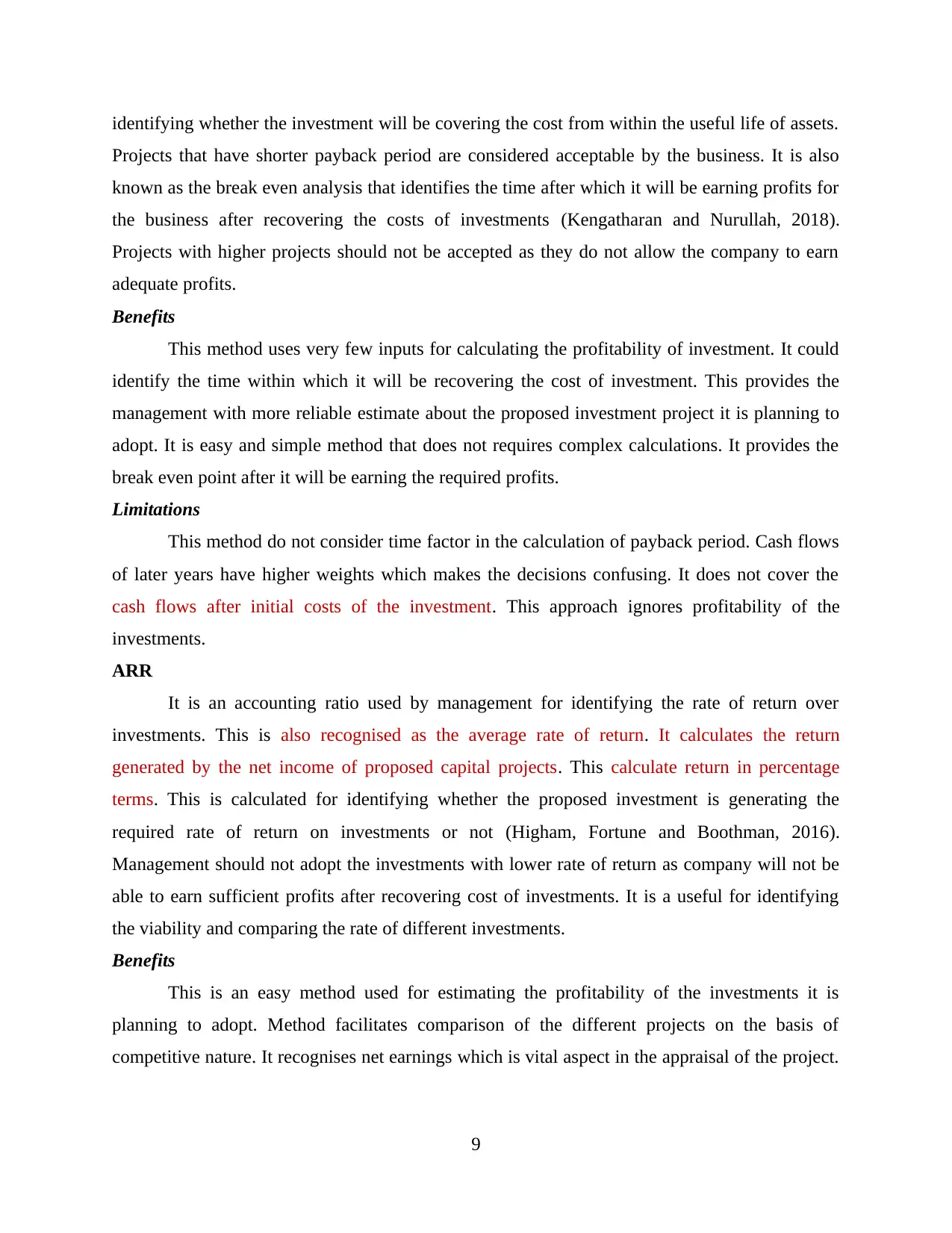
identifying whether the investment will be covering the cost from within the useful life of assets.
Projects that have shorter payback period are considered acceptable by the business. It is also
known as the break even analysis that identifies the time after which it will be earning profits for
the business after recovering the costs of investments (Kengatharan and Nurullah, 2018).
Projects with higher projects should not be accepted as they do not allow the company to earn
adequate profits.
Benefits
This method uses very few inputs for calculating the profitability of investment. It could
identify the time within which it will be recovering the cost of investment. This provides the
management with more reliable estimate about the proposed investment project it is planning to
adopt. It is easy and simple method that does not requires complex calculations. It provides the
break even point after it will be earning the required profits.
Limitations
This method do not consider time factor in the calculation of payback period. Cash flows
of later years have higher weights which makes the decisions confusing. It does not cover the
cash flows after initial costs of the investment. This approach ignores profitability of the
investments.
ARR
It is an accounting ratio used by management for identifying the rate of return over
investments. This is also recognised as the average rate of return. It calculates the return
generated by the net income of proposed capital projects. This calculate return in percentage
terms. This is calculated for identifying whether the proposed investment is generating the
required rate of return on investments or not (Higham, Fortune and Boothman, 2016).
Management should not adopt the investments with lower rate of return as company will not be
able to earn sufficient profits after recovering cost of investments. It is a useful for identifying
the viability and comparing the rate of different investments.
Benefits
This is an easy method used for estimating the profitability of the investments it is
planning to adopt. Method facilitates comparison of the different projects on the basis of
competitive nature. It recognises net earnings which is vital aspect in the appraisal of the project.
9
Projects that have shorter payback period are considered acceptable by the business. It is also
known as the break even analysis that identifies the time after which it will be earning profits for
the business after recovering the costs of investments (Kengatharan and Nurullah, 2018).
Projects with higher projects should not be accepted as they do not allow the company to earn
adequate profits.
Benefits
This method uses very few inputs for calculating the profitability of investment. It could
identify the time within which it will be recovering the cost of investment. This provides the
management with more reliable estimate about the proposed investment project it is planning to
adopt. It is easy and simple method that does not requires complex calculations. It provides the
break even point after it will be earning the required profits.
Limitations
This method do not consider time factor in the calculation of payback period. Cash flows
of later years have higher weights which makes the decisions confusing. It does not cover the
cash flows after initial costs of the investment. This approach ignores profitability of the
investments.
ARR
It is an accounting ratio used by management for identifying the rate of return over
investments. This is also recognised as the average rate of return. It calculates the return
generated by the net income of proposed capital projects. This calculate return in percentage
terms. This is calculated for identifying whether the proposed investment is generating the
required rate of return on investments or not (Higham, Fortune and Boothman, 2016).
Management should not adopt the investments with lower rate of return as company will not be
able to earn sufficient profits after recovering cost of investments. It is a useful for identifying
the viability and comparing the rate of different investments.
Benefits
This is an easy method used for estimating the profitability of the investments it is
planning to adopt. Method facilitates comparison of the different projects on the basis of
competitive nature. It recognises net earnings which is vital aspect in the appraisal of the project.
9
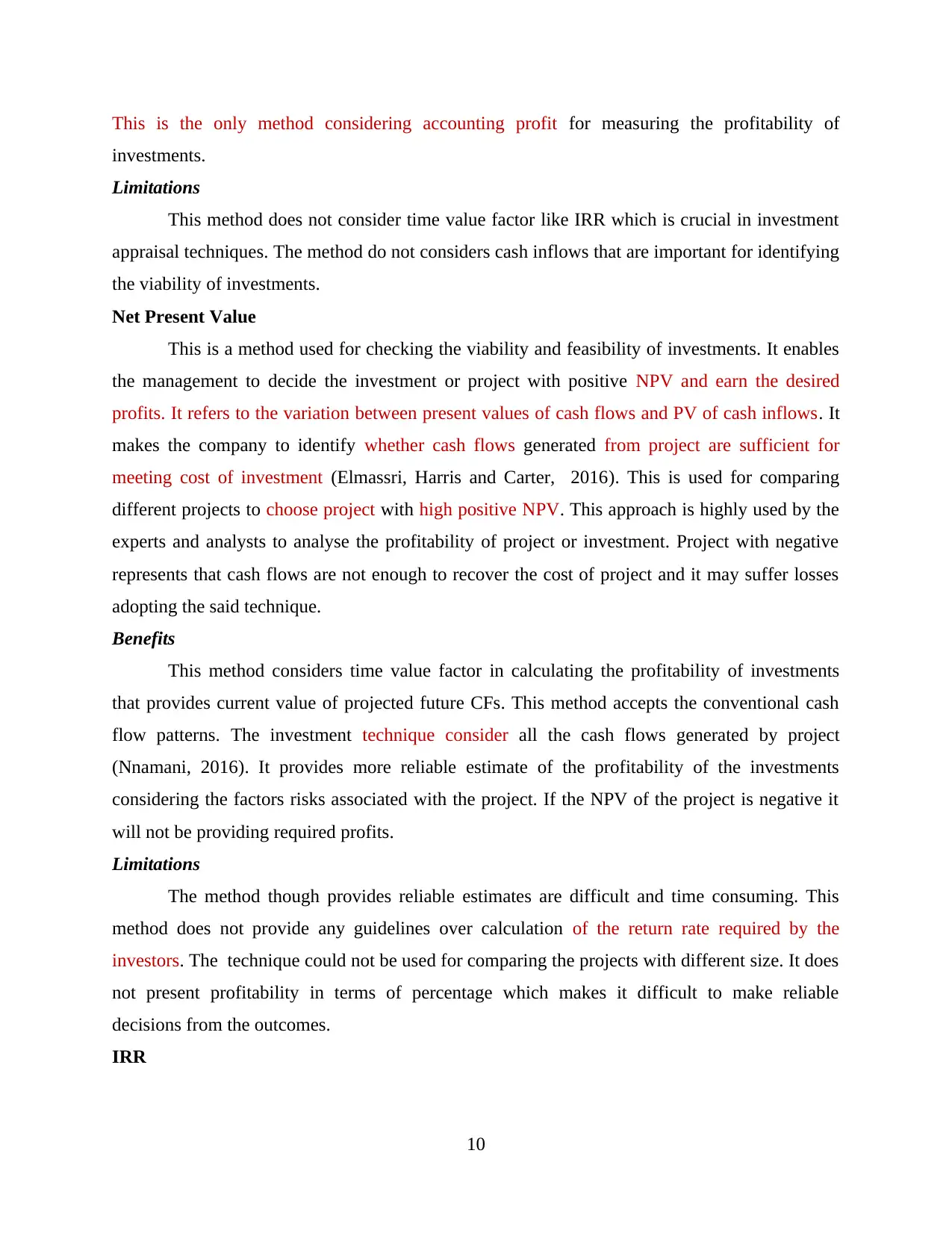
This is the only method considering accounting profit for measuring the profitability of
investments.
Limitations
This method does not consider time value factor like IRR which is crucial in investment
appraisal techniques. The method do not considers cash inflows that are important for identifying
the viability of investments.
Net Present Value
This is a method used for checking the viability and feasibility of investments. It enables
the management to decide the investment or project with positive NPV and earn the desired
profits. It refers to the variation between present values of cash flows and PV of cash inflows. It
makes the company to identify whether cash flows generated from project are sufficient for
meeting cost of investment (Elmassri, Harris and Carter, 2016). This is used for comparing
different projects to choose project with high positive NPV. This approach is highly used by the
experts and analysts to analyse the profitability of project or investment. Project with negative
represents that cash flows are not enough to recover the cost of project and it may suffer losses
adopting the said technique.
Benefits
This method considers time value factor in calculating the profitability of investments
that provides current value of projected future CFs. This method accepts the conventional cash
flow patterns. The investment technique consider all the cash flows generated by project
(Nnamani, 2016). It provides more reliable estimate of the profitability of the investments
considering the factors risks associated with the project. If the NPV of the project is negative it
will not be providing required profits.
Limitations
The method though provides reliable estimates are difficult and time consuming. This
method does not provide any guidelines over calculation of the return rate required by the
investors. The technique could not be used for comparing the projects with different size. It does
not present profitability in terms of percentage which makes it difficult to make reliable
decisions from the outcomes.
IRR
10
investments.
Limitations
This method does not consider time value factor like IRR which is crucial in investment
appraisal techniques. The method do not considers cash inflows that are important for identifying
the viability of investments.
Net Present Value
This is a method used for checking the viability and feasibility of investments. It enables
the management to decide the investment or project with positive NPV and earn the desired
profits. It refers to the variation between present values of cash flows and PV of cash inflows. It
makes the company to identify whether cash flows generated from project are sufficient for
meeting cost of investment (Elmassri, Harris and Carter, 2016). This is used for comparing
different projects to choose project with high positive NPV. This approach is highly used by the
experts and analysts to analyse the profitability of project or investment. Project with negative
represents that cash flows are not enough to recover the cost of project and it may suffer losses
adopting the said technique.
Benefits
This method considers time value factor in calculating the profitability of investments
that provides current value of projected future CFs. This method accepts the conventional cash
flow patterns. The investment technique consider all the cash flows generated by project
(Nnamani, 2016). It provides more reliable estimate of the profitability of the investments
considering the factors risks associated with the project. If the NPV of the project is negative it
will not be providing required profits.
Limitations
The method though provides reliable estimates are difficult and time consuming. This
method does not provide any guidelines over calculation of the return rate required by the
investors. The technique could not be used for comparing the projects with different size. It does
not present profitability in terms of percentage which makes it difficult to make reliable
decisions from the outcomes.
IRR
10
⊘ This is a preview!⊘
Do you want full access?
Subscribe today to unlock all pages.

Trusted by 1+ million students worldwide
1 out of 14
Related Documents
Your All-in-One AI-Powered Toolkit for Academic Success.
+13062052269
info@desklib.com
Available 24*7 on WhatsApp / Email
![[object Object]](/_next/static/media/star-bottom.7253800d.svg)
Unlock your academic potential
Copyright © 2020–2025 A2Z Services. All Rights Reserved. Developed and managed by ZUCOL.





